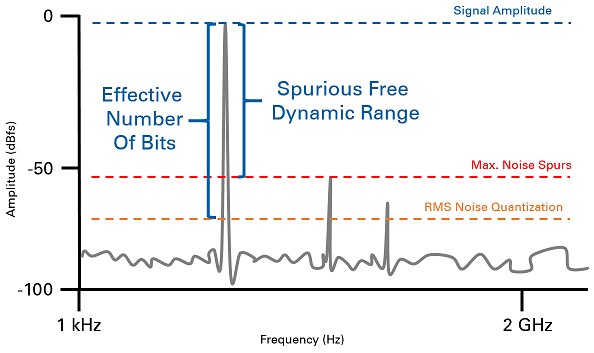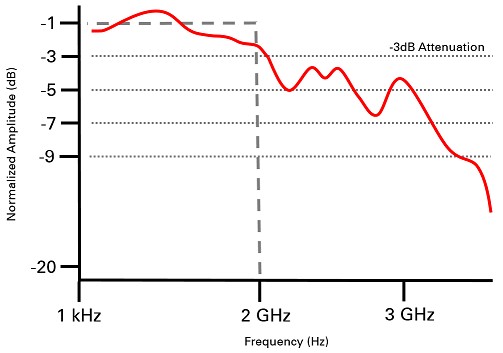3 Hidden Oscilloscope Specs That Really Matter
Overview
All oscilloscopes are listed with specifications like sampling rate, bandwidth, and voltage range, but are those the best specifications to use when you choose a new instrument? Although these are important pieces of information to have about a new piece of equipment, understanding the quality of an oscilloscope requires reading a little further into the user manual. See why the effective number of bits (ENOB), passband flatness, and -3 dB filter roll-off may be the most important specs you aren’t looking at.
Contents
Effective Number of Bits
ENOB of an oscilloscope is the actual measurement resolution after you have accounted for the distortion, noise effects, and spurs of the instrument. ENOB gives a much more accurate representation of the measurement performance of an oscilloscope than the resolution printed on the front panel or in the data sheet and is calculated directly from the signal-to-noise-and-distortion (SINAD) specification. Noise and device spurs are embedded into the measurements your oscilloscope takes and add voltage offsets and frequency components that are not part of the signal of interest.
Figure 1: Effective number of bits (ENOB) is a measure of oscilloscope resolution that takes noise and spurs of the instrument into account.
Instrument vendors can improve ENOB by using cutting-edge analog-to-digital converters with very low noise density and implementing advanced algorithms for data correction. When choosing a new oscilloscope look for one with a high ENOB, SINAD, or spurious free dynamic range (SFDR) specification to get the best measurement performance. The PXIe-5171R oscilloscope from NI is an example of a 14-bit oscilloscope that has relatively high ENOB (11-bit). NI also offers the PXI-5922 flex resolution oscilloscope with 16 to 24-bit resolution and spectral performance of up to 105 dB SINAD.
Learn more about calculating ENOB and SFDR in the white paper, Understanding Frequency Performance Specifications.
Passband Flatness
Don’t assume you are getting consistent amplitude measurements across your oscilloscope’s frequency range. The passband flatness specification is the consistency of amplitude measurements throughout the frequency measurement range of an oscilloscope. An oscilloscope with exceptional flatness will have little change in measured amplitude of the same voltage level at all frequencies it is specified to measure.
Figure 2: The typical frequency response of an oscilloscope (red) deviates greatly from the ideal, theoretical frequency response (grey) within the operating frequency of the oscilloscope, which can result in inaccurate measurements.
You can check this by looking at the frequency response Bode plot of the oscilloscope, signal-to-noise ratio or SFDR at multiple frequencies and observing the differences in the numbers, or the flatness specification of an instrument. An instrument with good flatness allows you to make measurements at any frequencies and compare data with minimal correction for frequency, which makes correlation easier and faster.
An example of an oscilloscope with excellent passband flatness is the 1.5 GHz, 10-bit PXIe-5162 oscilloscope. See the Bandwidth and Transient Response section of the PXIe-5162 specification document.
-3 dB Filter Roll-Off
When you use oscilloscopes as precise amplitude or frequency measurement devices, the inclusion of harmonic components and noise spurs can adversely affect measurements. All oscilloscopes have analog bandwidth specifications defined by the -3 dB point, but something that you should be more aware of is how much your measurements are being affected by signals beyond the specified bandwidth. Signals that occur in the extended operating frequencies of an oscilloscope can appear in the region that you are measuring through aliasing. You can combat these effects by using an oscilloscope with anti-aliasing filters for your particular region of interest or by finding an oscilloscope with a sharper filter roll-off, typically about -20 dB per decade.
Figure 3: The bandwidth spec on your oscilloscope doesn’t mean that high-frequency signals disappear. Oscilloscopes with poor -3 dB roll-off performance permit signals from outside of the operating frequency range to erroneously appear in the measurement spectrum.
An oscilloscope with an excellent low-pass filter response will roll off significantly after the -3 dB point. If the filter does not have adequate roll-off performance, spectral measurements can be significantly altered by aliased signals in the region of interest.
To learn more about aliasing and the Nyquist theory of sampling, see Acquiring an Analog Signal: Bandwidth, Nyquist Sampling Theorem, and Aliasing.
Learn More
- Learn about the fundamentals of oscilloscope operation and performance in the Instrument Fundamentals series.
- See all of the oscilloscopes that NI offers and find the one that meets your needs.
- Learn more about oscilloscope and digitizer specifications


